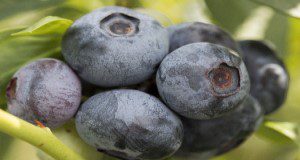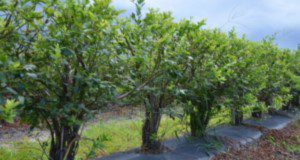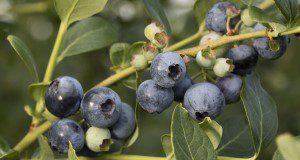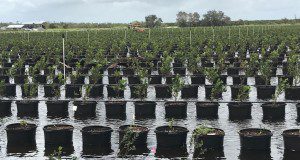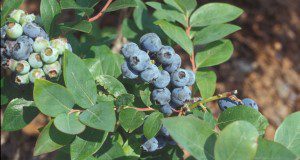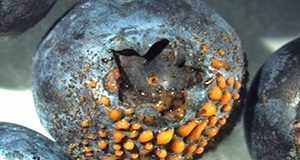There is a growing market in the United States and globally for fresh fruits and vegetables with reported health-enhancing properties. This includes blueberries, which are high in antioxidants and have been reported to improve heart health and contain anticancer properties. Fresh-market blueberry sales (conventional and organic) increased by 27% between 2013 and 2017, and that trend is expected to continue. In addition, there is an increasing level of consumer interest in organically grown produce (for environmental conservation, taste, and other perceived benefits), for which some consumers are willing to pay a premium over the price for a conventionally produced crop. This new 8-page publication of the UF/IFAS Horticultural Sciences Department discusses various aspects of organic blueberry production in Florida and is intended for use by those currently using or interested in pursuing organic production. Written by Douglas A. Phillips, Peter J. Dittmar, Philip F. Harmon, Oscar E. Liburd, Danielle D. Treadwell, and Jeffrey G. Williamson.
https://edis.ifas.ufl.edu/hs1400
Tag: Blueberry
Pruning Southern Highbush Blueberry in Florida
Pruning is an essential part of blueberry production and is used to help establish new plantings; promote postharvest growth of new foliage and fruiting wood; balance vegetative and reproductive growth; reduce disease and certain insect pressure; assist in harvesting efficiency; and promote new cane growth and plant longevity. This new 3-page publication of the UF/IFAS Horticultural Sciences Department is a discussion of pruning practices on southern highbush blueberry in Florida. Written by Douglas A. Phillips and Jeffrey G. Williamson.
https://edis.ifas.ufl.edu/hs1359
Nutrition and Fertilization Practices for Southern Highbush Blueberry in Florida
Research and field experience have demonstrated that fertilization is necessary to achieve proper growth and high yields in cultivated production of blueberries. This new 7-page publication of the UF/IFAS Horticultural Sciences Department provides guidance and management suggestions to Florida growers of southern highbush blueberry (SHB) for monitoring, supplying, and maintaining proper plant nutrition in commercial production operations. Written by Doug Phillips and Jeffrey G. Williamson.
https://edis.ifas.ufl.edu/hs1356
Impacts of Hurricane Damage on Southern Highbush Blueberries
Florida has been affected by eight hurricanes since 2000. This new 3-page publication discusses the types of hurricane damage that occur in blueberry production operations, the impacts of these damages, and some recommendations on best management practices in the aftermath of a storm. Written by Douglas A. Phillips, Jeffrey G. Williamson, and Philip F. Harmon and published by the UF/IFAS Horticultural Sciences Department.
https://edis.ifas.ufl.edu/hs1342
Florida Blueberry Leaf Disease Guide
Southern highbush blueberry (SHB) cultivars are commercially grown throughout much of Florida, in both deciduous and evergreen production systems. In both systems, leaves can be damaged by many factors including environmental conditions, chemical applications, insects, and diseases. This new 12-page publication of the UF/IFAS Plant Pathology Department includes basic information to assist growers in determining 1) the likely cause (fungal, viral, algal, or bacterial) of leaf symptoms, 2) when specific leaf spots are likely to occur, 3) characteristic symptoms of common leaf problems, and 4) some of the management options that are available. Written by Douglas A. Phillips, Norma C. Flor, and Philip F. Harmon.
http://edis.ifas.ufl.edu/pp348
Botryosphaeria Stem Blight on Southern Highbush Blueberry in Florida
Botryosphaeria stem blight is the most common and damaging fungal vascular disease on southern highbush blueberry in the southern United States, causing stem and cane dieback and reductions in yield. Advanced stages of this disease may cause premature plant death, which results in significant replanting costs for growers. Biotic or abiotic stresses from a variety of sources can make plants more susceptible to infection by stem blight pathogens. This new 5-page publication is intended for Florida blueberry growers to use as a guide in the identification and management of Botryosphaeria stem blight on southern highbush blueberry. Written by Norma C. Flor, Douglas A. Phillips, and Philip F. Harmon and published by the UF/IFAS Plant Pathology Department.
http://edis.ifas.ufl.edu/pp347
Anthracnose on Southern Highbush Blueberry
Information contained in this 4-page publication is intended for Florida blueberry growers to use as a guide in the identification of anthracnose, a group of fungal pathogens that affects a wide range of plants, including southern highbush blueberries (SHB). Written by Douglas A. Phillips, Maria C. Velez-Climent, Philip F. Harmon, and Patricio R. Munoz and published by the UF/IFAS Plant Pathology Department, May 2018.
http://edis.ifas.ufl.edu/pp337
Establishment and Production Costs for Southern Highbush Blueberry Orchards in Florida: Enterprise Budget and Profitability Analysis
The United States is the world’s largest producer of blueberries. Florida’s blueberry production represents a small fraction of total US production, but blueberries are nevertheless an important and valuable crop in the state because Florida growers benefit from the nation’s earliest market window. In fact, the average price for blueberries received by growers in Florida during the last three years was 2.5 times the US average.
This 15-page fact sheet written by Ariel Singerman, Marina Burani-Arouca, Jeffrey G. Williamson, and Gary K. England, and published by the UF Department of Food and Resource Economics provides a summary of the enterprise budget developed for highbush blueberry production in Florida. The budget represents a typical operation and serves as an economic benchmark for growers, providing estimates of expenses and potential estimates of revenue and profit for a blueberry crop to help current and potential blueberry growers make informed decisions about blueberry production.
http://edis.ifas.ufl.edu/fe1002
Improving the Precision of Blueberry Frost Protection Irrigation
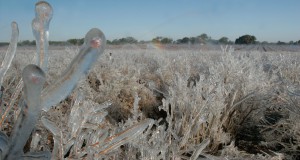
In Florida, early-ripening southern highbush blueberry cultivars allow growers to take advantage of high prices in the early market before other states can compete with higher volumes of berries sold at lower prices. That advantage comes with a vulnerability, however, because frosts can reduce gains. Florida growers rely on strategies like cold protection irrigation to reduce their risk of loss due to cold damage. This 9-page article by Tatiana Borisova, Tori Bradley, Mercy Olmstead, and Jeffrey Williamson describes a UF/IFAS study comparing precision cold protection irrigation to uniform cold protection irrigation to estimate the potential savings in diesel costs and water withdrawal volumes associated with the two practices and help protect Florida’s valuable and vulnerable blueberry harvest. Published by the Food and Resource Economics Department in November 2015.
http://edis.ifas.ufl.edu/fe979
An Overview of US Blueberry Production, Trade, and Consumption, with Special Reference to Florida
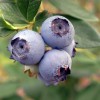 This 8-page fact sheet provides updated information about the recent trends in blueberry production, consumption, and trade for the US market. Current and future short-term trends are discussed. Price analysis at the wholesale level for selected markets on the US East Coast (New York City) and US West Coast (Los Angeles) are presented. Also, the national average retail prices for conventional and organic blueberries are presented. Written by Edward A. Evans and Fredy H. Ballen, and published by the UF Department of Food and Resource Economics, October 2014.
This 8-page fact sheet provides updated information about the recent trends in blueberry production, consumption, and trade for the US market. Current and future short-term trends are discussed. Price analysis at the wholesale level for selected markets on the US East Coast (New York City) and US West Coast (Los Angeles) are presented. Also, the national average retail prices for conventional and organic blueberries are presented. Written by Edward A. Evans and Fredy H. Ballen, and published by the UF Department of Food and Resource Economics, October 2014.
http://edis.ifas.ufl.edu/fe952
Southern Highbush Blueberry Cultivars from the University of Florida
 Many improved southern highbush cultivars have been developed by the University of Florida breeding program since the initial releases of ‘Sharpblue’, ‘Flordablue’, and ‘Avonblue’ in the mid-1970s. Today there are more blueberry cultivar choices available for Florida growers than ever before, but in every case, cultivar selection involves weighing the advantages and disadvantages of a cultivar relative to the grower’s needs. Unfortunately, there are no perfect cultivars suited for every location and management system. This 10-page fact sheet categorizes southern highbush cultivars into four groups: major cultivars, secondary cultivars, new options, and historical cultivars. Proper cultivar selection is critical to a successful blueberry enterprise, and growers should seek information from multiple sources, including their local county Extension office. Written by J.G. Williamson, J.W. Olmstead, G.K. England, and P.M. Lyrene, and published by the UF Department of Horticultural Sciences, April 2014.
Many improved southern highbush cultivars have been developed by the University of Florida breeding program since the initial releases of ‘Sharpblue’, ‘Flordablue’, and ‘Avonblue’ in the mid-1970s. Today there are more blueberry cultivar choices available for Florida growers than ever before, but in every case, cultivar selection involves weighing the advantages and disadvantages of a cultivar relative to the grower’s needs. Unfortunately, there are no perfect cultivars suited for every location and management system. This 10-page fact sheet categorizes southern highbush cultivars into four groups: major cultivars, secondary cultivars, new options, and historical cultivars. Proper cultivar selection is critical to a successful blueberry enterprise, and growers should seek information from multiple sources, including their local county Extension office. Written by J.G. Williamson, J.W. Olmstead, G.K. England, and P.M. Lyrene, and published by the UF Department of Horticultural Sciences, April 2014.
http://edis.ifas.ufl.edu/hs1245
Protected Culture for Vegetable and Small Fruit Crops: Southern Highbush Blueberry Cultivars under High Tunnels
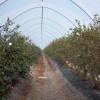 High tunnels have been proposed as an alternative for freeze protection and to increase fruit earliness of southern highbush blueberry. But there is no information about the effect of this type of structure on southern highbush blueberry fruit earliness under subtropical Florida conditions. This 3-page fact sheet summarizes the results of 2-year study in a commercial southern highbush blueberry farm in North Central Florida to compare early fruit weight in high tunnels to that of open fields. This 3-page fact sheet was written by Bielinski M. Santos and Teresa P. Salame-Donoso, and published by the UF Department of Horticultural Sciences, July 2013.
High tunnels have been proposed as an alternative for freeze protection and to increase fruit earliness of southern highbush blueberry. But there is no information about the effect of this type of structure on southern highbush blueberry fruit earliness under subtropical Florida conditions. This 3-page fact sheet summarizes the results of 2-year study in a commercial southern highbush blueberry farm in North Central Florida to compare early fruit weight in high tunnels to that of open fields. This 3-page fact sheet was written by Bielinski M. Santos and Teresa P. Salame-Donoso, and published by the UF Department of Horticultural Sciences, July 2013.
http://edis.ifas.ufl.edu/hs1226
How to Calculate Fertigation Injection Rates for Commercial Blueberry Production (HS1197)
 To increase nutrient and water use efficiencies and reduce nutrient leaching and environmental concerns, fertigation is recommended for commercial blueberry production. In fact, successful fertigation can enhance sustainability and maximize profitability for commercial blueberry enterprises. One of the key factors in fertigation is the correct calculation of fertilizer injection rate and time for the acreage. This publication helps blueberry growers correctly calculate fertigation injection rates and times and provides reference tables for checking injection rates and times needed for a variety of production scenarios. This 3-page fact sheet was written by Guodong Liu, Jeffrey Williamson, Gary England, and Alicia Whidden, and published by the UF Department of Horticultural Sciences, March 2012.
To increase nutrient and water use efficiencies and reduce nutrient leaching and environmental concerns, fertigation is recommended for commercial blueberry production. In fact, successful fertigation can enhance sustainability and maximize profitability for commercial blueberry enterprises. One of the key factors in fertigation is the correct calculation of fertilizer injection rate and time for the acreage. This publication helps blueberry growers correctly calculate fertigation injection rates and times and provides reference tables for checking injection rates and times needed for a variety of production scenarios. This 3-page fact sheet was written by Guodong Liu, Jeffrey Williamson, Gary England, and Alicia Whidden, and published by the UF Department of Horticultural Sciences, March 2012.
http://edis.ifas.ufl.edu/hs1197
Reproductive Growth and Development of Blueberry (HS976/HS220)
 This 7-page fact sheet discusses flower bud initiation and development, pollination and fruit set, fruit development and yeild, and the use of plant growth regulators. Written by J. G. Williamson, J. W. Olmstead, and P. M. Lyrene, and published by the UF Department of Horticultural Sciences, February 2012.
This 7-page fact sheet discusses flower bud initiation and development, pollination and fruit set, fruit development and yeild, and the use of plant growth regulators. Written by J. G. Williamson, J. W. Olmstead, and P. M. Lyrene, and published by the UF Department of Horticultural Sciences, February 2012.
http://edis.ifas.ufl.edu/hs220
Florida’s Commercial Blueberry Industry (HS742/AC031)
 The Florida blueberry industry has grown rapidly because Florida growers can produce high-quality fruit when few fresh berries are available and berry prices are high. Although southern highbush blueberry acreage has expanded significantly in Florida, Georgia, California, and Mexico during the last several years, better cultivars and improved cultural practices have increased grower production efficiency during the last several years, with promising production trends for the future profitability. This 4-page fact sheet was written by J. G. Williamson, J. W. Olmstead, and P. M. Lyrene, and published by the UF Department of Horticultural Sciences, February 2012.
The Florida blueberry industry has grown rapidly because Florida growers can produce high-quality fruit when few fresh berries are available and berry prices are high. Although southern highbush blueberry acreage has expanded significantly in Florida, Georgia, California, and Mexico during the last several years, better cultivars and improved cultural practices have increased grower production efficiency during the last several years, with promising production trends for the future profitability. This 4-page fact sheet was written by J. G. Williamson, J. W. Olmstead, and P. M. Lyrene, and published by the UF Department of Horticultural Sciences, February 2012.
http://edis.ifas.ufl.edu/ac031
Protecting Blueberries from Freezes in Florida (HS968/HS216)
 Blueberry growers: know when the conditions are right in commercial blueberry fields, during and after bloom, for freeze damage, as well as practices you can use to minimize it. This 7-page fact sheet was written by J.G. Williamson, P.M. Lyrene, and J.W. Olmstead, and published by the UF Department of Horticultural Sciences, January 2012.
Blueberry growers: know when the conditions are right in commercial blueberry fields, during and after bloom, for freeze damage, as well as practices you can use to minimize it. This 7-page fact sheet was written by J.G. Williamson, P.M. Lyrene, and J.W. Olmstead, and published by the UF Department of Horticultural Sciences, January 2012.
http://edis.ifas.ufl.edu/hs216
Blueberry Gardener’s Guide (CIR1192/MG359)
 Home gardeners: Use this guide to successfully grow blueberries in Florida. This 8-page fact sheet was written by J.G. Williamson, P.M. Lyrene, and J.W. Olmstead, and published by the UF Department of Horticultural Sciences, January 2012.
Home gardeners: Use this guide to successfully grow blueberries in Florida. This 8-page fact sheet was written by J.G. Williamson, P.M. Lyrene, and J.W. Olmstead, and published by the UF Department of Horticultural Sciences, January 2012.
http://edis.ifas.ufl.edu/mg359
